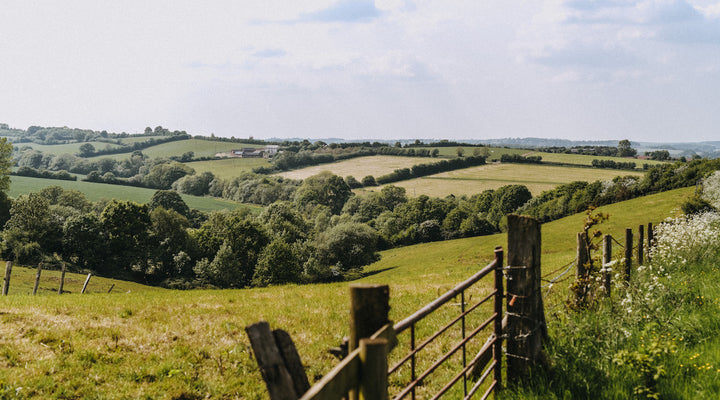We are in a dance with all the creatures on the farm: the flora and fauna of the soil, the hedges and woods, even in and on the cheese. And people are particularly interested in the domestic animals we have, the cattle who provide milk for our cheese, and meat from the male animals that are born, and cows after their working lives are over.
Our animals are largely grazed on fresh or preserved grass, growing where it’s challenging to grow crops for people to eat. Our grass fields are laid down for several years and many are permanent, and with several species of plants to enrich the animals’ diet and the soil’s health. Grass sequesters carbon in the soil. There is a discussion about how much carbon the soil holds (it can’t go on adding more indefinitely). We look to increase the soil carbon and on some suitable fields, harvest some of that organic matter for a crop to feed and bed animals. It’s a fair exchange, seeing how much it improves the crop and saves artificial fertiliser. We can’t take too much or the soil loses some of its ability to be a filtering sponge, and we return the ground to grass to restore it.
Our animals are a wonderful mix of several different breeds, Holstein, Friesian, Swedish Red and little touches of Montbeliard and Jersey. Our cows are robust, happy to graze outside in all seasons, produce enough milk that is good for cheese, and not so much they aren’t looking after themselves. We want them to calve in time with the seasons: they need grass when there’s plenty around.
I love seeing our animals grazing outside, each cow focussed on harvesting her share of grass one mouthful at a time. Animals also enjoy the shelter of the barn, particularly when the soil is too tender to hold them. A barnful of contented cows is a quiet pleasure while we wait on them and serve their every need.
Our animals produce methane, a powerful and short lived greenhouse gas. That means if the number of animals doesn’t change, no more methane gets added. Some argue, ‘then have fewer animals to reduce warming’. We are preferring to breed animals for lower methane, both for each litre of milk and for each animal, so that we make best use of the methane they do produce. Our animals in the UK produce about half the amount of greenhouse gas to milk than the global number. The carbon we sequester in organic matter in woodland, field and hedge halves it again.
Our animals don’t just eat grass, hay and straw. Their miraculous fermenting vats, their rumens, make good use of fibrous residues from human food: pulp after the sugar is pressed from beet, the hard bits of maize after the cornstarch has gone, the cake left after oilseed rape is crushed for oil, bran, wheatgerm and straw from human crops and so on. The ‘livestock on leftovers’ approach does a good job of optimising land and feed. They eat grain and straw, grown on ours and others’ fields, often as a break for a refresh of pasture, and on some land that will not grow human edible grains.
Cows at the end of their milking lives, and the beef calves they produce, make for an efficient way of producing the beef we do eat. They are animals that arise from producing milk, rather than have a separate group of animals. It’s important we care for, respect and honour these animals and this stage of life, as much as the animals we spend years with.
Food from animals has a better range of nutrients than food from plants, including some dairy and meat substitutes. We are designed as omnivores, and our microbiome (our extraordinary fermenting vat) thrives on variety. As with our microbiome, a varied macrobiome in our landscape reflects our diet and our sense of wonder: crop and pasture fields, hedges, woods and wild corners make a rich, beautiful and interconnected environment. Given what it takes to produce animals, it works to eat a little less of them and their products and better.
People have polarised views on animals in farming. It was refreshing to read this clear analysis of the debate and how people see it in different ways.
I’m thrilled that Academy of Cheese will cover this in Hero Hirsh’s magnificent exposition of the sustainability issues around dairy farming for her Master of Cheese submission and Level 3 learning materials. www.academyofcheese.org
Breewood, H., & Garnett, T. (2023). Meat, metrics and mindsets: Exploring debates on the role of livestock and alternatives in diets and farming. TABLE Explainer. TABLE, University of Oxford, Swedish University of Agricultural Sciences and Wageningen University and Research. doi.org/10.56661/2caf9b92
Mary Quicke








